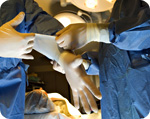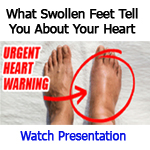
Is Modern Medicine Founded on Error?
Friday, December 07, 2007 by: Gabriel Donohoe
Tags: germ theory, health news, Natural News
- Hidden poison in your medicine and supplements: How phthalates in capsules are silently attacking your heart, thyroid, and hormones
- When the storm brings spies: How a top weather app became an agent of surveillance
- Hidden betrayal: Moderna and Pfizer shots hijack immune cells to rewrite mRNA, prolonging spike protein production
- Lard: A highly nutritious but misunderstood superfood
- Judge rules Kansas vaccine lawsuit against Pfizer must proceed in state court
- Health Ranger Report: Dr. Alphonzo Monzo discusses nanotechnology, 5G and the weaponization of health
- CLIMATE PONZI SCHEME DENIED: Trump begins the exit of the BIGGEST WASTE of money, resources and human lives ever and the climate alarmists are freaking out
- Breakthrough study reveals how Epstein-Barr and a gene variant heighten multiple sclerosis risk
- The mouth-brain connection: Could dental health guard against dementia (and vice versa)?
- EU court exposes secret Pfizer deal, orders von der Leyen and Bourla to reveal concealed texts
- Pfizer’s election meddling exposed: Top scientists weaponized science to sway the 2020 vote, so they could benefit from unlawful mandates
- Rudolf Breuss introduces a natural approach to treating cancer and chronic illness in “The Breuss Cancer Cure”
- Thwarted ISIS plot on Michigan military base highlights ongoing domestic terror threat
- X-class solar flare sparks worldwide disruptions, with more storms expected as sunspot turns toward Earth
- Coinbase faces $400M fallout after insider-led phishing attack exposes customer data
- From lifesaving to life-threatening? Study finds CT scans could be causing cancer
- The water cure: Unveiling the hidden link between dehydration, obesity, cancer and depression
- FDA considers overhaul of infant formula requirements amid growing concerns over nutrition and safety
- WAR ON COGNITION: The Coordinated Assault on Your Brain and How to Defend Yourself Against Every Attack
- Singapore's draconian vaccine mandate: Citizens face jail time for refusing FORCED medical procedures that do HARM
- Big Pharma's Dirty Secret: How Prescription Drugs Are Starving Your Body of Essential Nutrients
- Canada's COVID cover-up: Health officials swore secrecy to protect Trudeau from vaccine scandal
- RED ALERT: Nuclear War Between India and Pakistan Could Trigger Global Catastrophe… full RISK ANALYSIS
- JESUS NEVER SPOKE ENGLISH: Historical facts on why the Bible you’re probably reading has been altered, redacted or hidden from much of its original meaning
- Gene-edited pork sneaks onto your plate: FDA quietly approves CRISPR pigs amid health and ethical concerns
- Silent catastrophe: COVID-19 vaccines linked to plummeting fertility rates, Czech data reveals
- Why All Government Officials and Big Tech CEOs Who Engage in Systematic Viewpoint Censorship Must Be ARRESTED, Prosecuted, and Sentenced to Life in Prison
- Brushing with poison: Study finds toxic heavy metals in 90% of toothpaste brands, including those for children
- Survival basics: 5 Dangerous locations to avoid during an EMP attack
- BBC accused of “political censorship” for shelving Gaza documentary amid mounting pressure
- EU embraces censorship over solutions as energy grid crises spark blackout fears
- Health Ranger Report: Christopher Bjerknes challenges conventional narratives about world history
- Australia’s vaccine cover-up: 35 died same day as COVID shot, but authorities ignored them
- Landmark study of 85 million reveals shocking surge in heart attacks, strokes, and sudden death following the notorious COVID-19 jab
- Hidden poison in your medicine and supplements: How phthalates in capsules are silently attacking your heart, thyroid, and hormones
- The truth about Benzyl Alcohol in beauty products
- The Miraculous Healing Power of DMSO: Nature's Forgotten Cure for Cancer, Pain, and Regeneration
- Biblical truth: God will carry out a “cosmic reset” of Earth and destroy all human civilization with a series of extinction-level cosmic impacts known as The Seven Trumpets, Seven Bowls and Seven Seals
- URGENT REPORT: The China Import Embargo - What to Stockpile Now Before America Runs Out
- The Ultimate Survival Guide to Baking Soda: A Miraculous, Multi-Purpose Remedy for Health, Home, and Emergency Preparedness
- Widespread social and economic unrest: Steve Quayle issues urgent financial warning of imminent asset collapse in new interview with Mike Adams
- Aerosolized bioweapons? Strange “diploid biomasses” falling out of the sky in Florida captured under the microscope
- A call to preserve America’s future: “Defeating Big Government Socialism” by Newt Gingrich
- Stunning Visualization of the Seven Trumpets in the Book of Revelation
- Big Pharma launches “Vaccine Integrity Project” to combat Secretary Kennedy and keep 94 shots going into kids with mandates and liability protections
- World Economic Forum's current downfall exposes legacy of totalitarianism, financial fraud, and crimes against humanity
- Biden regime deployed over 600 grants to fund disinformation agenda, to silence the truth and stifle debate
- The Miraculous Healing Power of Green Tea: Unlocking the Potent Antioxidants That Big Pharma Doesn't Want You to Know About
- The unspoken truth about chemotherapy: These “treatments” create toxic time bombs in your body called CELL-KILLING PARTICLES
- U.S. Government's Bio-War Against America: 15 Historical Medical Horrors Inflicted on the American People by the Government Itself
- A win for free speech: State Department SHUTS DOWN controversial disinformation office
- U.S. demands U.K. protect FREE SPEECH, repeal hate speech authoritarianism, in latest trade deal negotiations
- French rioting demonstrates how gun control laws are failing law-abiding citizens
- Head of L.A. Port warns of incoming plunge in U.S. supply chain, empty shelves and inventory depletion in 5-7 weeks
- Red Cross issues warning to stop blood plasma donations from vaccinated people
- Scientists confirm: GENIUS brain function can be spontaneously unleashed in humans without any apparent cause
- EPA advisor admits the agency is funneling billions to climate groups ahead of Trump’s return to White House
- HYSSOP: What research reveals about the health benefits of this ancient holy herb
- Two containers with completed ballots fall out of truck in Florida
- Newly released JFK files reveal Pentagon's role in creating Lyme disease and covid in the same lab
- Mike Adams releases country western hit single: Goin’ Back in Time is Comin’ Home
- Global leaders unite to clamp down on “misinformation” with UN-backed Cascais Declaration
- BREAKING: 2025 NDAA authorizes mandatory military draft of WOMEN across America… as Pentagon pursues global NUCLEAR war with both Russia and China at the same time
- I Want My Bailout Money – new song released by Mike Adams
- Michael Yon warns of a ZIONIST TAKEOVER in Trump’s second administration
- Ozempic and Wegovy weight loss drugs are injectable LIZARD VENOM PEPTIDES that may unleash a devastating wave of organ failure… side effects align with symptoms of SNAKE BITES
- The Health Ranger releases “Vaccine Zombie” song and music video, using AI-animated zombies for the music video
- BOMBSHELL: DNA testing kits are a SCAM to develop ethnic-specific bioweapons
- These 13 countries just signed an agreement to engineer a global FAMINE by destroying food supply
- Israeli soldiers accused of even more torture and abuse in the West Bank
- RFK Jr. clears key hurdle: Sen. Susan Collins backs controversial HHS nominee, signaling a new era for health policy
- Sermon 30: How Jesus reveals Caesar’s FAKE CURRENCY and FALSE AUTHORITY
But with a huge increase today in infectious diseases and the rapidly rising epidemic of cancer, diabetes, heart disease and other chronic illnesses; we have to wonder if Pasteur's theory is really that sound.
Consider this alarming statistic from a report commissioned by the Nutrition Institute of America in October, 2003: 2.2 million hospital patients suffer Adverse Drug Reactions (ADRs) to prescribed medicine each year leading to the deaths of 106,000 people. In other words, over 2,000 Americans die each week from properly prescribed medicine in properly prescribed doses.
This is a serious indictment of pharmaceutical medicine which is inextricably based on Pasteur's germ theory.
According to Pasteur:
· Germs, or microbes, cause disease
· Germs invade the body from the outside, i.e., air, water, or food
· Human blood is sterile and can only be infected by outside microbes
· Germs are monomorphic, i.e., they have only one form and can be identified by species
· Specific diseases are caused by specific germs
· Germs should be killed by pharmaceutical drugs
In the 1870s Pasteur's germ theory was developed further by William Koch, a contemporary and rival of Pasteur, whose proofs of the germ theory are still known today as "Koch's Postulates". See Koch's Postulates at (http://en.wikipedia.org/wiki/Koch's_postulates)
Basically, Koch's contribution to the germ theory was to prove that a specific type of germ caused a specific disease, that the germ would be found in all people suffering from that particular disease but not healthy people, and that every person exposed to these germs would fall ill with disease.
However, Koch had to abandon part of his first postulate when he discovered that healthy people could carry the germs of certain diseases and yet show no symptoms. He also had to revise his third postulate when it was shown that some people could be exposed to virulent germs yet not catch the disease.
The "proofs" of the new Germ Theory were already showing flaws.
Still, despite being highly controversial in the late 1800s, the Germ Theory was quickly adopted by the medical powers of the day. This new theory about germs invading from outside the body empowered the medical and pharmaceutical industry as guardians of human and animal health. People became dependent on the fledgling medical/drugs industry for information and protection from disease. Thus, Modern Medicine was born.
A number of eminent scientists opposed Pasteur and The Germ Theory, most notably the highly respected Professor Antoine Béchamp. Béchamp was a reserved, modest man and a much more distinguished scientist than the self-promoting chemist, Louis Pasteur. (It is believed today that Pasteur stole much of Béchamp's work and passed it off as his own. This prompted R.B. Pearson to write a book in the 1940s called "Pasteur, Plagiarist, Imposter.") See text at (http://www.whale.to/a/b/pearson.html)
Béchamp and other scientists believed in the theory of pleomorphism, that a microbe could evolve through many forms from virus to bacterium to yeast to fungus to mold and could even de-evolve back to a pre-virus again. Béchamp could see this evolution and de-evolution clearly in his microscope. Big Medicine rejected pleomorphism back then just as it will not even look at pleomorphic phenomena filmed and documented by scientists today, such as Dr. Robert O. Young in San Diego, California.
Another of Béchamp's contemporaries, Claude Bernard, expounded on the pleomorphic theory and said that the inner terrain or "milieu interieur" was the cause of disease, and not microbes. It was discovered that acidic blood and tissue provide a terrain that is ideal for disease to develop. When the terrain becomes acidic, microbes evolve into pathogenic forms and carry out the work nature designed them to do – as cleaners and undertakers, scavenging inflamed or infected tissue.
The acidity or acid/alkaline balance of the blood is measured by pH, the potential of Hydrogen, see (http://en.wikipedia.org/wiki/PH) and is a very important marker for good health. The blood will do all it can to keep its pH at 7.365, or slightly alkaline. It will even strip alkaline reserves like calcium from the bones to buffer a rise in acidity. (This can lead to a condition labelled by modern medicine as osteoporosis.)
When the pH drops, even by .1, the increase in acidity is interpreted by the microbes, already present in the body in their billions, as a sign of a dead or dying body. This prompts them to morph from benign bacteria into virulent yeast and mold so that they can reduce the body to the dust from whence it came.
Even Pasteur eventually realized the truth of this and on his death-bed said that "Bernard was right... the microbe is nothing; the terrain is everything." But Big Medicine now chose to ignore him. They sensed that the germ theory provided a gilt-edged opportunity to amass a huge fortune.
Béchamp and others in the scientific community opposed the germ theory and advocated the theory of pleomorphism, saying:
· Acidic terrain, not germs, cause disease
· Germs are already in the body by the billions and don't necessarily have to come from without (although that can sometimes happen)
· Blood is not sterile but can contain many microbial forms
· Germs are pleomorphic, i.e., they can change through many forms (Dr Gaston Naessens identified a microbe undergoing 16 different stages of evolution)
· Virtually all diseases are caused by acidic terrain
· Diseases can be prevented or reversed by increasing the alkalinity of the terrain
What led Professor Béchamp to formulate his pleomorphic theory was the discovery of great numbers of small grainy objects in live blood samples which he observed through his microscope. Many of his contemporaries dismissed these tiny life forms as laboratory contamination which were of no importance. But they intrigued Béchamp. He named them "microzymas" or "little bodies".
He found microzymas present in every cell in the bloodstream, in animals, in plants, and even in rocks. He found them present in the remains of dead animals many years after the animal's body had withered away to dust. He observed that in a healthy organism, microzymas work at repairing and nourishing all cells; but when the terrain becomes acidic, the microzymas morph into viruses, bacteria, yeast, fungus, and mold and prepare to break the host down.
Béchamp's work was ignored, ridiculed, suppressed, and soon forgotten. Down through the years, some scientists discovered pleomorphic phenomena for themselves - Enderlein, Rife, Reich, Livingston-Wheeler, Naessens, and more recently, in the U.S., Dr. Robert O. Young (San Diego) and Dr. David Jubb (New York). Most had no recourse to the works of earlier scientists and thought that their discoveries were unique to them. Like Béchamp before them, they too found their discoveries ignored or suppressed.
All of them were fascinated with the "little bodies" that Béchamp had called "microzymas". Enderlein called them "protits", Livingston-Wheeler called them "Progenitor cryptocides", and Naessens called them "somatids". But all found that they couldn't destroy these "little bodies" even when subjecting them to excessive carbonizing temperatures or high dosage radiation.
Dr. David Jubb calls them "Colloids of Life" and says that they are indestructible. They resist "enormous heat, radiation, and chemicals and can reside in petrochemical solution, in hot rock deep within the Earth, in meteorites and in radioactive water inside nuclear power stations. Upon the loss of life of its host, colloid of life return to the earth. A colloid of life is the unknown factor between the animate and the inanimate." (Jubbs Cell Rejuvenation, p.14.)
That last sentence has quite a resonance. Dr. Jubb is saying that colloids of life, or microzymas, are the smallest observable life forms between spirit and matter.
We still have a lot to learn about life, medicine, and healing but we need to approach these things with an open, inquisitive mind.
How long will it take modern medicine to accept that germs don't cause disease but only appear as a result of disease? Who will fund research into the pleomorphic work begun by Béchamp, Enderlein, Rife and others? Who is brave enough to confront Big Pharma's doctrinaire, Pasteurian approach to drug based medicine?
When a group of people are exposed to a virus or food toxin, modern medicine examines only those who get sick. What they should do is examine those who didn't get sick. One would no doubt find that the sick people had acidic blood and tissue while those who didn't succumb to the virus/toxin were alkaline. Therein lies the key to health.
Disease cannot take hold in an alkaline body. An alkalising diet and way of living can prevent and reverse disease. But don't expect this to be endorsed by orthodox medicine – there's no profit in it.
Recommended reading: "Sick And Tired..." and "The pH Miracle" by Dr. Robert O. Young, "Rethinking Pasteur's Germ Theory" by Dr. Nancy Appleton, "Alkalize Or Die" by Dr.T.A. Baroody, "The Cancer Cure That Worked" by Barry Lynes, "Jubbs Cell Rejuvenation" by Dr. David Jubb, and "The Blood And Its Third Anatomical Element" by Prof. Antoine Béchamp.
About the author
Gabriel Donohoe is a writer, researcher, Shamanic counsellor, and natural health therapist in Ireland. He can be reached at: gdonohoe@iol.ieGerm theory at FETCH.news
Get independent news alerts on natural cures, food lab tests, cannabis medicine, science, robotics, drones, privacy and more.
Take Action: Support Natural News by linking to this article from your website
Permalink to this article:
Embed article link: (copy HTML code below):
Reprinting this article:
Non-commercial use OK, cite NaturalNews.com with clickable link.
Follow Natural News on Facebook, Twitter, Google Plus, and Pinterest
Science News & Studies
Medicine News and Information
Food News & Studies
Health News & Studies
Herbs News & Information
Pollution News & Studies
Cancer News & Studies
Climate News & Studies
Survival News & Information
Gear News & Information
News covering technology, stocks, hackers, and more



"Big Tech and mainstream media are constantly trying to silence the independent voices that dare to bring you the truth about toxic food ingredients, dangerous medications and the failed, fraudulent science of the profit-driven medical establishment.
Email is one of the best ways to make sure you stay informed, without the censorship of the tech giants (Google, Apple, Facebook, Twitter, YouTube, etc.). Stay informed and you'll even likely learn information that may help save your own life."
–The Health Ranger, Mike Adams












































